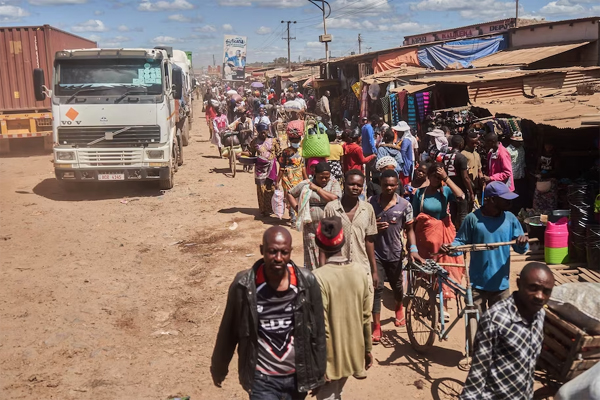
Matthew Hill and Eric Martin | Bloomberg
MBONBELA, South Africa/WASHINGTON
EnergiesNet.com 02 17 2023
More than half of the world’s low-income countries are at high risk of debt distress or already in it, and several have defaulted. But despite the world’s 20 largest economies having agreed in 2020 to a plan called the Common Framework to smooth the process of restructuring loans that governments could no longer afford to service or repay, not a single nation has actually gotten relief under it so far. Critics say negotiations take way too long to conclude. Delays have partly stemmed from disagreements between the rich countries that have traditionally guided sovereign debt restructurings and China, which is now a major international creditor. It wants multilateral lenders like the World Bank to absorb some of the losses, an approach those institutions are resisting along with many developed nations, most vocally the US.
1. How big is the debt problem?
Indebted governments from Latin America to Africa spent money they didn’t have to shore up rickety health systems during the coronavirus pandemic and provide a safety net for citizens. Then central banks, led by the US Federal Reserve, began increasing interest rates to quell inflationary pressures that were compounded by a surge in grain and fuel prices stemming from Russia’s invasion of Ukraine. That raised the value of the dollar, which added to the pain of those who had borrowed internationally. The 75 poorest nations owed their creditors about $326 billion at the end of 2021, latest World Bank data show. By early 2023, Zambia and Sri Lanka had defaulted and Ghana was on the verge of doing so. Those in debt distress included Lebanon and Argentina.

2. What is the Common Framework?
Drawn up by the Group of 20 nations and the six-decade-old Paris Club, which represents creditors in mostly developed nations, it is a mechanism to help coordinate the restructuring of debts owed to disparate funders. It brought Paris Club members together with China, Saudi Arabia and other lenders for the first time. The IMF and World Bank, which heralded the initiative as a breakthrough in efforts to put financially stretched countries back on a sound footing, pledged to help provide analysis and new financing. The framework envisions private creditors like banks accepting common, or comparable, restructuring terms to government lenders. It remains unclear how they will be persuaded to come on board. Just one private lender participated in a separate G-20 program known as the Debt Service Suspension Initiative that enabled 48 nations to halt payments during the pandemic before it expired at the end of 2021.
3. How does the process work?
Governments first have to negotiate a plan with the IMF to return their borrowing to sustainable levels, which would be achieved mainly by reining in spending and increasing revenue collection in addition to securing debt relief. Once that process is complete, they need to sit down with an official committee comprising representatives from their creditor nations and hammer out a deal that could entail debt writedowns, loan extensions or reduced servicing costs, or a combination of all three. They are then required to seek comparable relief from their private creditors. The Common Framework approaches debt restructuring on a case-by-case basis.
4. Which countries have tried to use it?
More than 70 nations are eligible for relief, but only four had applied by February 2023: Chad, Zambia, Ethiopia and Ghana. Only Chad has completed the process, but its negotiations were so protracted that it no longer needed relief by the time they were concluded in late 2022 because a spike in energy prices had shored up its oil-fired economy. Zambia and Ethiopia remained mired in talks, while Ghana was still in the initial stages of seeking relief, which it reluctantly applied for after it was shut out of international debt markets.
5. What’s the problem?
Besides the complexity of the multi-stage process, there are differences of opinion between China and Western nations, such as the US and France, over how the restructuring should be handled, what it should entail and who should bear the burden. Besides wanting the World Bank to take losses on its loans, China has requested that local-currency debt held by foreigners in Zambia be included in a deal. The IMF has warned that that could trigger financial instability, while the US argues that reworking Zambia’s local-currency debt isn’t feasible and would leave it with a more unaffordable burden down the line. China has also questioned some of the assumptions made in the IMF’s analysis of debt sustainability. Those tensions have made untangling a Gordian knot of debts owed to private creditors and new lenders like Chinese state banks even more complex.
6. Why is China such a key player?
China has become the world’s biggest bilateral creditor to developing and emerging nations since announcing its Belt and Road infrastructure construction initiative in 2013. It’s unclear exactly how much money it is owed because details of its lending aren’t public. Research from Boston University’s Global Development Policy Center shows that China Development Bank and Export-Import Bank of China, the nation’s two biggest international development lenders, committed almost $500 billion in funding to 100 countries between 2008 and 2021. That equates to 83% of the sovereign lending made by the World Bank over the same period. Ten borrowers — Angola, Argentina, Bangladesh, Brazil, Ecuador, Iran, Kazakhstan, Pakistan, Russia and Venezuela — accounted for almost 60% of the loan commitments. Nearly two-thirds of the Chinese banks’ financing was targeted at mineral extraction, pipelines, transport and power projects, while the World Bank has typically supported the provision of health, education and other services.
7. Can this be fixed?
IMF Managing Director Kristalina Georgieva wants set timelines for debt restructuring to be incorporated within the framework to ensure the process doesn’t drag on, and for the types of debt that would be covered by the program to be clearly defined. The World Bank has proposed that debt payments be immediately suspended for nations that apply for relief under the framework. Some bond holders and other private creditors have said they should be involved in the restructuring from much earlier in the process rather than being brought in during the final stages. There have also been calls to allow middle-income countries like Sri Lanka to apply for relief under the program, rather than restricting eligibility to poor nations.
–With assistance from Ana Monteiro.
bloomberg.com 02 15 2023

 Let’s celebrate the strength, courage and incredible contributions of women around the world. https://www.EnergiesNet.com Portal of Latin America and the Caribbean with news and information on Energy, Oil, Gas, Renewables, Engineering, Technology and Environment
Let’s celebrate the strength, courage and incredible contributions of women around the world. https://www.EnergiesNet.com Portal of Latin America and the Caribbean with news and information on Energy, Oil, Gas, Renewables, Engineering, Technology and Environment








